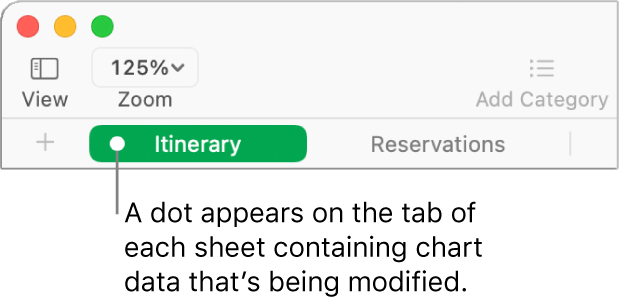
Modify chart data in Numbers on Mac
You can modify a chart’s data references (numbers, dates or durations) at any time. You can add and remove an entire data series, or edit a data series by adding or deleting specific data from it.
While you’re editing a chart’s data references, a dot appears on the tab of each sheet that contains data used in that chart.

If you can’t edit a chart, it may be locked. Unlock it to make changes.
Add or delete a data series
Click the chart, click Edit Data References, then do any of the following in the table containing the data:
Remove a data series: Click the dot for the row or column you want to delete, then press Delete on your keyboard.
Add an entire row or column as a data series: Click its header cell. If the row or column doesn’t have a header cell, drag to select the cells.
If the chart uses rows as series, then you can add only rows; if it uses columns as series, then you can add only columns.
Add data from a range of cells: Drag over the table cells.
Add or remove data from an existing data series: Click the dot for the row or column, then drag the corner of the selection box to include the cells you want.
Change the order of data series: In the Format
 sidebar, click the Series tab, click the disclosure arrow next to Data, then click the Order pop-up menu and choose a data series.
sidebar, click the Series tab, click the disclosure arrow next to Data, then click the Order pop-up menu and choose a data series.
Click Done in the bar at the bottom of the window.
Switch rows and columns as data series
When you add a chart, Numbers defines the default data series for it. In most cases, if a table is square or if it’s wider than it is tall, the table rows are the default series. Otherwise, the columns are the default series. You can change whether rows or columns are the data series.
If your table contains categories and you choose a column as the data series, you can also choose whether you want the chart to include summary or body cells.
Click the chart, then click Edit Data References.
Click the pop-up menu in the bar at the bottom of the window, then choose Plot Columns as Series or Plot Rows as Series.

Click Done on the right side of the bar.
Include hidden data in a chart
In a table, you can hide specific rows or columns and filter data. When you use a table with hidden or filtered data to make a chart, by default that data isn’t included in the chart, but you can choose to include it if you want.
Click the chart.
In the Format
 sidebar, click the Chart tab, then select the Hidden Data tickbox in the Chart Options section.
sidebar, click the Chart tab, then select the Hidden Data tickbox in the Chart Options section.
For more information about how to hide table rows or columns, see Add or remove rows and columns in Numbers on Mac.
About chart downsampling
If a column, bar, line or area chart references a table with a large number of data points, the chart automatically shows a representative sample of each series to improve the performance of Numbers. Downsampling doesn’t change or remove the data in your table, and only changes the visible data points in the chart.
If your chart data is being downsampled, a message appears when you click Large Data Set in the Chart tab of the Format ![]() sidebar.
sidebar.
If you want to see certain data points in your chart, you need to create the chart from a smaller table or a smaller selection of data from a large table.